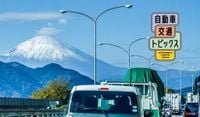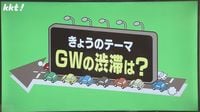As the Golden Week approaches, NEXCO Central Japan has released its traffic congestion forecast for the expressways across the nation, predicting significant delays for travelers. The forecast covers the period from April 25 to May 6, 2025, with the highest congestion expected on the Tomei and Shin-Tomei Expressways.
According to NEXCO, the downbound lanes will experience the most severe traffic on May 3 and May 4, while the upbound lanes are expected to see heavy congestion from May 3 to May 5. On May 2, the Tomei Expressway is anticipated to face maximum congestion of 40 kilometers, particularly on the downbound side.
The forecast outlines a total of 22 predicted instances of traffic jams exceeding 10 kilometers on the Tomei and Shin-Tomei Expressways combined. For instance, on April 25, from 5:00 AM to 3:00 PM, congestion is expected near Tokyo IC on the upbound lane, with delays of up to 10 kilometers, translating to an estimated travel time of 40 minutes from Yokohama Aoba IC.
Similarly, on the same day, from 6:00 AM to 10:00 AM, congestion near Yokohama Aoba IC is predicted to reach 15 kilometers, with an estimated travel time of 45 minutes from Ayase Smart IC. The congestion continues throughout the week, with various stretches of the expressway experiencing delays during peak hours.
On April 27, for example, the forecast indicates congestion near Yokohama Aoba IC, where delays could reach 10 kilometers between 2:00 PM and 10:00 PM. On May 2, the congestion is expected to peak between 6:00 AM and 9:00 AM, with delays of up to 10 kilometers, and later in the day, from 2:00 PM to 9:00 PM, the delays could extend to 15 kilometers.
Heavy congestion is also predicted for the downbound lanes of the Tomei Expressway on May 3 and May 4, with the most significant delays expected near the Ayase Smart IC. This stretch of road is a known bottleneck during holiday travel, and drivers are advised to plan their trips accordingly.
Experts recommend avoiding peak travel times to mitigate the stress of traffic jams. NEXCO advises travelers to consider departing at off-peak hours or using alternative routes to circumvent the anticipated congestion. For instance, avoiding travel in the early morning hours on May 3 and May 4 could help drivers avoid the worst of the traffic.
In addition to the Tomei Expressway, other expressways across Japan are also expected to experience significant congestion during Golden Week. The Tohoku Expressway, for example, is predicted to face delays of 10 kilometers near Hanyu IC on April 27, and the Kan-Etsu Expressway is expected to see similar delays.
Travelers should also be aware that the ETC holiday discount will not apply on certain days during Golden Week, specifically on April 26, 27, and 29, as well as from May 3 to May 6. This information is crucial for those planning to use expressways during this busy travel period.
As travel demand increases, particularly for domestic trips, the average budget for Golden Week in 2025 is projected to be 29,237 yen, a 5% increase from the previous year. Rising prices and a weaker yen are cited as reasons for this increase.
A travel agency in Sendai has noted a surge in demand for domestic travel, especially to popular destinations like Miyako Island in Okinawa. According to Megumi Hayashi, the sales manager at Tour Wave Sendai, charter flights to Miyako Island are fully booked, reflecting a significant rise in domestic travel applications compared to last year.
While domestic travel is booming, overseas trips to nearby destinations like Taiwan and South Korea have seen a slight decline, down about 10% from the previous year.
As Golden Week approaches, it’s essential for travelers to stay informed about traffic conditions and to plan their journeys carefully. NEXCO provides real-time updates on traffic conditions, and travelers are encouraged to check these resources before hitting the road.
In summary, the Golden Week traffic forecast indicates a busy travel period, particularly on the Tomei and Shin-Tomei Expressways. With significant congestion expected, careful planning and awareness of peak travel times can help ensure a smoother journey for all travelers.







